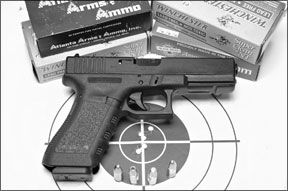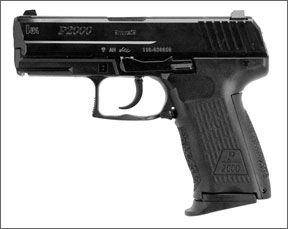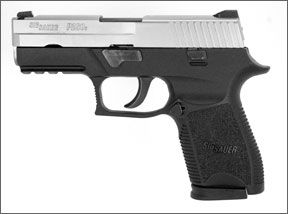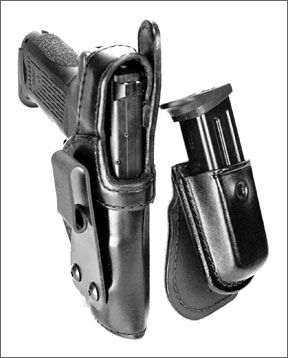In this test we shot three double-action-only pistols designed for duty or personal self defense. Medium to large in size, they carry few levers, and this snag-free characteristic also makes them attractive for concealed carry. Two of the three guns, the $879 Heckler & Koch P2000 LEM V2 and SIG Sauer’s $749 P250 Two-Tone, utilize a hammer and firing pin for ignition. The $599 Glock G17, arguably the gun that started the polymer DAO revolution, relies on the preparation and release of a striker to impact the primer. Despite any similarities between the guns, this test challenged us to master vastly different trigger techniques.

We began our tests from the 25-yard line supported by bench and sandbag. What better way to learn a trigger than limiting variables to grip, sight alignment, and a controlled press? We then added a second test. This would require landing rapid-fire hits on an 8.5-by-16-inch target from a distance of 5 yards, two shots at a time. Our shooter began each string of fire standing unsupported with a two-handed grip and sights on target but with finger off the trigger. We pasted a black 1-inch-wide dot in the center to provide a point of aim. Upon audible start signal from our CED electronic timer, we engaged the target as quickly as possible. Given that each stroke of the trigger both prepared and released the striking mechanism, we wanted to know how quickly and accurately we could land two hits on target one after another. We fired ten pairs and looked for a total of 20 hits on target. This test was performed twice. The second time we concentrated on applying what we learned from the first run. The rapid-fire test was performed firing one of our favorite practice rounds, Black Hills’ 115-grain FMJ ammunition sold in blue 50-round boxes. From the benches we tried Winchester’s new 105-grain jacketed softpoint Super Clean NT (nontoxic) ammunition; 124-grain full-metal-jacket rounds by Winchester USA, and 147-grain Subsonic jacketed hollow point Match rounds by Atlanta Arms and Ammo. Here is what we learned.
SIG Sauer P250 Two-Tone 9mm, $749
Big news at the Exeter, New Hampshire, plant not only includes a change of name from Sigarms to SIG Sauer, but also the release of a new pistol. The P250 featured a double-action system that raised the hammer smoothly in direct proportion to movement of the trigger. The stroke was long but the same length every time. Aside from the single-action 1911-style pistols, other SIG Sauer trigger systems are not as simple. Some models feature a double-action first stroke with the hammer remaining cocked thereafter and the trigger resetting rearward in the trigger guard. Until manually decocked, subsequent shots are fired single-action only. This system has also been offered with a shorter reset to the trigger labeled the SRT pattern. There is also a DAK trigger that works as a fulltime double-action mode with two separate reset points offering two different levels of resistance. But the P250 is different.

The amount of take-up or free play in the trigger is negligible. As soon as the trigger begins to move, the hammer starts to the rear. The point at which the hammer falls is quite far from its starting point, but if the operator decides not to shoot there is ample opportunity to release the trigger and safely lower the hammer. The trigger does not reclaim the ability to raise the hammer until it is completely forward to its rest position. The hammer cannot be thumbed back.
Whether the chamber was loaded or not or whether the slide has been racked, the hammer always appeared in the same downward position. This leads us to a problem that we have not had to deal with in a long time. In view of rule number one for handling a firearm, “Treat all handguns as if they are loaded,” perhaps it should not be referred to as a problem. The situation was that the loaded or unloaded condition of the P250 was never obvious. Most pistols either show a hammer back or there is a cutaway in the barrel hood. Many models offer an indicator to tell us when the chamber is loaded or action cocked. The extractor on the P250 carried a ridge on its outer edge similar to the one found on the Glock pistol. But the amount that the extractor bulged outward when the chamber was loaded was small, making indication too discreet, in our opinion, to be relied upon.
Another major innovation in the design of the P250 was its modular construction. The P250 consists of a polymer grip module, the subassembly including trigger, hammer, locking block and frame rails, and the slide, which housed the barrel and recoil assembly. Changing grip modules required that the takedown lever be removed. Lifting forward and up, the subassembly can be removed from the grip module. The subassembly is actually the only part that is serialized and registered as a weapon. In this way the grip module can be changed to fit a variety of hands with no more penalty than replacing the panels on a 1911, for example. Even the top end can be swapped out, presumably to change caliber and perhaps even barrel length. The modular design might eventually permit receivers with different-length grips altering capacity. Capacity of our pistol was 15+1.

As of this report much of the versatility regarding grip size, caliber, barrel length, and so on is still in the future. Eventually, you will be able to put your hands on all three grip modules before purchase, but as of our writing only pistols with the medium-size grip module in place have been available. If we hadn’t shopped the well-stocked shelves of Fountain Firearms in Houston, Texas, (fountainfirearms.com), we may not have found one at all.
The medium grip frame featured a somewhat bulbous feel. Front and rear straps showed an effective nonskid grip. The sides were stippled. There was an indent that leads the finger to the trigger on one side and a purchase point for the thumb on the other. The two indents could serve either purpose. Other ambidextrous points were the reversible magazine release and a slide release found on either side. Chambered for 9mm, the P250 was a pretty easy gun to hold on to. The grip module also featured an accessory rail with three cross hatches. Our P250 came with stainless steel slide and night sights. Basic field-stripping was accomplished by locking back the slide and rotating the takedown lever.
The modular capability of the SIG Sauer P250 should not, in our opinion, overshadow the quality of its trigger. Whether a long DAO stroke is your cup of tea or not, we have to admit that this is one of the smoothest we’ve tried. The sights were also very clear, which is essential because sight alignment must be adjusted continuously in order to be ready for breaking the shot. From the bench the P250 shot groups that measured on average just about 2 inches across with both the Winchester Non Toxic 105-grain rounds and the Atlanta Arms and Ammo 147-grain Subsonic Match ammunition.
Our first impression from shooting the P250 was that it was unusually prone to muzzle flip. We couldn’t say if the gun was actually generating more recoil or if it was a product of the grip, which one of our staffers described as being similar to holding on to a light bulb. Submitting the P250 to our rapid-fire test told us more.
The P250 was the first gun we tested. In our initial set we rang up two-shot strings averaging 0.63 seconds in duration. We didn’t know how this would compare with the other guns, but we did know we were working really hard to keep the trigger moving. But our efforts paid off. The first set of ten two-shot strings produced only one miss. We told our shooter to slow down and get all 20 hits. He reported the sensation of slowing down on the next string, but when rounded off, the elapsed time still averaged out to 0.63 seconds. We think the sensation of slowing down was merely the shooter becoming more familiar with the gun. This time all 20 shots were on target. That we could learn from the first set of runs and apply it effectively just minutes later tells us that the gun was easier to learn than expected, and feedback from the sights and trigger was reliable.
In terms of first-shot capability, the trigger can be prepped in one continuous motion, assuming there is a definite reason to shoot. But like each of our DAO pistols, riding the trigger in anticipation can be dangerous. For a quick first shot from a position of finger outside the trigger guard, training is important but gun-to-hand fit is essential. We think we would have to try all three grip modules to find out which would be best. That an onsite mockup wearing the three different modules will be available may help but it could also be misleading. In our opinion, judging the effectiveness of a grip without actually shooting the gun is akin to pronouncing a pair of shoes to be comfortable while lying in bed.
Glock G17 9mm, $599
Today’s G17 is likely the pistol closest to the original Glock. To date Glocks have proven durable and economical. One of the latest changes is the addition of an accessory rail along the dust cover. The initial appeal of the Glock pistol was largely based on its capacity (16+1) and simplicity. The field-stripping regimen is a good example. Retract the slide about one-quarter inch while pulling down on the slide latches. Remove the slide by pushing it forward off the frame. To reset the slide, apply it from the front and shift it rearward until it clicks into place. No tools necessary.
The G17 fired from a barrel that measured just less than 4.5 inches. The trigger on this pistol was the least complicated and easiest to learn of our test guns. We measured resistance to be about 8.5 pounds, and there was little variation in feel throughout the sweep of the trigger. Glock refers to this design as the SafAction trigger, but it qualifies as being double-action design because it serves to both compress and release the spring that drives forward the striker. If we were to provide a visual image of how this differs from a hammer driven system perhaps the striker could be referred to as being a cue stick and the cue ball the primer. A hammer-driven gun might be illustrated by using a hammer and chisel to strike the primer. When the chamber is loaded, the extractor bulges outward, and this can be confirmed visually or by touch.
From the bench we discovered that the sights offered very little light to the left and right sides of the front sight blade. But we were able to print a 1.3-inch group firing the Winchester 105-grain Super Clean JSP rounds on the way to establishing a 1.7-inch average firing this new product. During rapid fire we found it impossible to track the thin cracks of light showing between the interior of the notch and the front sight blade. Instead, we tried to keep the large white dot on the front sight inside the bold white outline surrounding the rear notch. The more experienced competitive shooters on our staff said they would have preferred a more open sight picture.
Setting up for our rapid-fire test we noticed right away how much bigger the G17 was than the other guns in the test. One characteristic that added to this sensation was the square profile of the slide. The average elapsed time of our first set of ten two-shot drills was 0.64 seconds with one shot off target. We tried slowing down on our next set in an attempt to land all 20 shots. But at the end of the second set, we were still missing one shot on target.
We would like to point out a positive to the boxy profile of the Glock slide. At closer range we experimented with using the rear profile of the gun instead of the sights. We found that as long as we saw the rear panel of the slide as a perfect square and not the sides of the gun, our shots were lined up.
Heckler & Koch P2000 LEM V2 9mm, $879
The P2000 fired from a 3.6-inch barrel measured from the muzzle to the rear of the barrel hood. It had three-dot sights dovetailed into place. A removable pin integrated with the left-side slide release retained the slide. There was a matching slide-release lever on the right side that stayed with the pistol when the pin was removed. The rear portion of the recoil assembly played a part in locking and unlocking the barrel during cycling. A shock buff rode up and down the captured recoil spring. When the action had been cocked, the hammer settled slightly ajar above the firing pin.

The magazine release consisted of a paddle available from either side at the lower rear corner of the trigger guard. The movement for release was downward instead of inward. Our long-fingered shooters used the thumb, and our short-fingered shooters used their middle finger to drop the magazine.
The front side of the grip was stippled, and the basepad of the 13-round magazine completed the length of the front strap. No less than four different size and shape back straps, each of them stippled, was supplied to accommodate different sizes of hands. We used the medium grip panel and were completely satisfied with the ergonomics of the P2000 LEM.
The LEM system found on the P2000 Variant 2 (V2) is HK’s proprietary DAO system. Our first impression of the LEM trigger was not altogether positive. The Glock 17 had offered a smooth sweep with constant tension. The SIG Sauer P250 offered a smooth sweep with relatively little tension.
In our evaluation of the SIG Sauer P250, we noted that the trigger was free flowing all the way through its stroke, but the shot could be cancelled at any time up to the point at which the hammer was about to drop. The same could be said of the LEM, with one significant difference. The break point, or more accurately the break zone, of the LEM trigger was clearly delineated. The P250 offered little or no feel as to when the hammer would fall, but the shooter could always tell when the trigger of the HK was up against the sear.
If the purpose of a DAO system is to provide added safety, then perhaps the LEM system is the better choice. We found that the trigger was capable of delivering accuracy from a controlled press, and the operator always knew where he was in the firing sequence.
After examining our targets from the bench session, we began to feel better about the LEM system. The HK P2000 LEM was the only pistol to print five-shot groups measuring less than 2 inches across on average with all three test rounds. (Overall average size for all groups measured by all three guns firing this impressive new ammunition was 1.8 inches across.) The P2000 LEM shot the Winchester 105-grain JSP NT rounds into five-shot groups with variation as little as 0.2 inches (1.4 inches to 1.6 inches across).
But how did the LEM trigger translate to rapid fire? In our first set of rapid fire, our times varied wildly from 0.68 to 0.91 seconds. The average time was 0.79 seconds, and all 20 shots were found on target. In our second set we started to settle in, finding the break consistently and dropping our average to 0.77 seconds. Not a big change, but this time the clock showed little variation in elapsed time, and once again all 20 shots were on target. The first shot of each two-shot string was the more difficult to accomplish. From outside the trigger guard to engaging the trigger and finding the break was complicated, compared to setting up the next shot.
0408-Sigarms-P250-Two-Tone-9mm.pdf






























